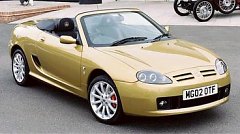 In
1995 Rover launched a new roadster called MGF. The car violated with
all
the MG traditional values - firstly, it was mid-engined, unlike any
previous
British roadsters; secondly, it was styled to emphasis sophistication,
unlike the honest expression of MG TC or MGA/B/C; thirdly, it employed
an unproven Hydragas suspension instead of conventional springs and
dampers.
This was eventually proved to be the reason for its inert handling. The
Hydragas struts were also expensive to source and not free from leakage
after extended use. This kind of risky engineering was far removed from
the way Morris Garage used to make cars. There were also other reasons
why the MGF experiment failed, such as poor ergonomics and ugly styling
from Gerry McGovern. Excluding home market UK, MGF consistently slipped
behind competitors Mazda MX-5 and Toyota MR-S. Among the 77,000 cars
sold
in 6 years, half of which were taken by patriots. In
1995 Rover launched a new roadster called MGF. The car violated with
all
the MG traditional values - firstly, it was mid-engined, unlike any
previous
British roadsters; secondly, it was styled to emphasis sophistication,
unlike the honest expression of MG TC or MGA/B/C; thirdly, it employed
an unproven Hydragas suspension instead of conventional springs and
dampers.
This was eventually proved to be the reason for its inert handling. The
Hydragas struts were also expensive to source and not free from leakage
after extended use. This kind of risky engineering was far removed from
the way Morris Garage used to make cars. There were also other reasons
why the MGF experiment failed, such as poor ergonomics and ugly styling
from Gerry McGovern. Excluding home market UK, MGF consistently slipped
behind competitors Mazda MX-5 and Toyota MR-S. Among the 77,000 cars
sold
in 6 years, half of which were taken by patriots.
Entered the Phoenix group which wants to emphasis the brand image of MG (if there is any left after ruined by MG Metro / Maestro / Montego and the F itself), the MGF underwent a big surgery. The first revision came out was a limited edition called Trophy 160, as reported here last April. The car got 50% stiffer suspensions and all the rubber bushings removed from suspension subframes to sharpen chassis response. Further with the VVC K-series 1.8 engine tuned to deliver 160hp via improved breathing and reprogrammed ECU, the result was nearly a hardcore driver’s car. Nearly. The second wave is a much bigger reconstruction, ranging from facelift to all-new suspensions. MG Rover’s new design chief Peter Stevens - the guy who penned McLaren F1 and various Lotuses - gave the new car a much sharper and cleaner front-end incorporating a new corporate nose and a nice-looking rectangular mouth with mesh grilles. Accompany with reshaped headlamps the car looks much more handsome. Stevens, a designer familiar with aerodynamics, also reshape the tail spoiler to cut aerodynamic lift. The new car looks so different that MG decided to give it a new name - MG TF. Interestingly, Isuzu claims the TF name belongs to one of its trucks, but in fact MG had already used this name to its roadster in 1953.
A few words about the power steering. Back in 1995 MGF was probably the first car to employ pure electric power steering. While the F itself and most followers fail to deliver real feedback, the improved version in TF seems finally do it successfully, as you will see later. Less impressive are the engines. Basically, they are still those K-series engines. 5 years ago the K might be world-beating, but today they are just average. The top 1.8-litre still employs the company’s unique VVC variable-valve timing mechanism which not only varies cam phasing but also varies the duration of valve opening. As in Trophy 160, it is tuned to deliver an impressive 160 horsepower (15-20hp more than competitors) in a peaky and noisy manner. The non-VVC version, previously producing 120hp, has been tuned to deliver 135hp. The budget 1.6-litre K-series has also received a few more horsepower to 115hp. According to the number of horsepower, these cars are named TF160, TF135 and TF115 respectively. All drives through an unchanged 5-speed manual. Alternatively, you can order a 120hp 1.8-litre with Steptronic CVT - pardon me, after the BMW-era it has been renamed to "Stepspeed". Never mind, keen drivers won’t consider a CVT, especially such a poor CVT. Other buyers are better to consider the sequential-manual Toyota MR-S SMT instead. On the Road
The 160hp VVC engine, as experienced in Trophy 160, is strong but peaky. It needs at least 4000rpm to get into its power band. This would not have been a problem were the gearshift not so balky. However, once you enter its power zone, the VVC engine will rev linearly and eagerly towards its 7100rpm cut-out. MG claims 0-60mph take 6.9 seconds. This might be a little bit optimistic considering the roadster weighs 1115kg. However, undoubtedly the TF160 is quicker than most rivals.
However, the Japanese rivals still shine in terms of driver communication, gearchange and ergonomics. Most important, they ride like limousines compare with the TF. Now you start understanding how MG made it more driver focused than rivals - it sacrifices ride quality to obtain higher handling precision. With sports suspension package, the ride is so crashy that nearly unacceptable. With standard suspension, it won’t display the aforementioned handling either. Some may say the
most hardcore
drivers will choose MG TF, but don’t forget Lotus have a pair of
roadsters
even quicker, more exciting to drive and rides far more comfortable.
They
are Elise and Speedster. |
| The above report was last updated on 17 Feb 2002. All Rights Reserved. |
 The
chassis of TF is a further development from the Trophy 160. Having
already
stiffened suspensions and mounted the subframes solidly on chassis, and
the result was still no complete success, MG finally decided to dump
the
Hydragas struts in favour of traditional coil springs and dampers. What
links the wheels to the chassis now consist of double-wishbones at the
front and multi-link at the rear. Other modifications include a 20%
increase
of chassis torsional rigidity by reinforcing sills, a quicker steering
rack with weightier servo, an enlarged set of brakes .... you can see
this
is a big reconstruction.
The
chassis of TF is a further development from the Trophy 160. Having
already
stiffened suspensions and mounted the subframes solidly on chassis, and
the result was still no complete success, MG finally decided to dump
the
Hydragas struts in favour of traditional coil springs and dampers. What
links the wheels to the chassis now consist of double-wishbones at the
front and multi-link at the rear. Other modifications include a 20%
increase
of chassis torsional rigidity by reinforcing sills, a quicker steering
rack with weightier servo, an enlarged set of brakes .... you can see
this
is a big reconstruction.  Despite
of Stevens’ effort, the MG TF still lives under the nightmare of the
McGovern
profile - the tail is too high, the wheels look small compare with the
high shoulder line, and the car does not really look like a mid-engined
machine. The exposed and manually-operated soft-roof is also clearly
outdated.
The interior, despite of new trimming, is as flawed as ever. The driver
seat is so high that taller drivers will find their legs touching the
dashboard
and steering wheel. This could be a painful place to have a long
journey.
After modifying so many things, why not a pair of new seats ?
Despite
of Stevens’ effort, the MG TF still lives under the nightmare of the
McGovern
profile - the tail is too high, the wheels look small compare with the
high shoulder line, and the car does not really look like a mid-engined
machine. The exposed and manually-operated soft-roof is also clearly
outdated.
The interior, despite of new trimming, is as flawed as ever. The driver
seat is so high that taller drivers will find their legs touching the
dashboard
and steering wheel. This could be a painful place to have a long
journey.
After modifying so many things, why not a pair of new seats ?
 For
those enjoying the easy going manner of the old car, they will be
shocked
by how different the TF perform. All controls - steering, clutch,
gearshift
and brakes - feels weighty. With the first turn of the steering wheel
you
can easily tell this is a focused driver’s car. It is sharp and
precise,
offering more feedback than the MGF. Ultimately, when the car
approaches
its limit mid-corner, it does not provide as much communication as
Mazda
MX-5 and Toyota MR-S, but the MG feels rock steady in corners and uses
its 215mm rear tyres to resist oversteer very well. Push too hard, it
will
understeer gently. Lift off, the nose will tuck in just a little bit,
the
tail still glues to the tarmac. Under the same conditions, MR-S will
have
its rear end break away suddenly and scare its driver.
For
those enjoying the easy going manner of the old car, they will be
shocked
by how different the TF perform. All controls - steering, clutch,
gearshift
and brakes - feels weighty. With the first turn of the steering wheel
you
can easily tell this is a focused driver’s car. It is sharp and
precise,
offering more feedback than the MGF. Ultimately, when the car
approaches
its limit mid-corner, it does not provide as much communication as
Mazda
MX-5 and Toyota MR-S, but the MG feels rock steady in corners and uses
its 215mm rear tyres to resist oversteer very well. Push too hard, it
will
understeer gently. Lift off, the nose will tuck in just a little bit,
the
tail still glues to the tarmac. Under the same conditions, MR-S will
have
its rear end break away suddenly and scare its driver.